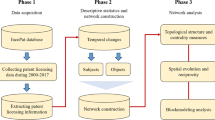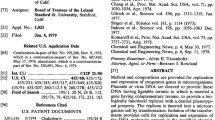Abstract
To explore the rules of knowledge transfer and application activities in knowledge space, defined at both temporal and spatial scales, the present study employs a unique dataset of Chinese patent licensing during the period of 2000–2012, with a total of 91,551 patents. Our results indicate that 70 % of patents were licensed out in the first 3 years. As time elapses, the annual average technology age decreases. There is a moderate difference among different types of licensors and patent types but not technology domains. With regards to the spatial dimension, 86 % of patents were licensed out within 1,000 km. The annual average geographical distance exhibits the same trend as technology age. Except for technology domains, a moderate difference among licensors and patent types is observed. Moreover, the interaction between geographical distance and technology age shows that as the technology age increases, this technology appears to be transferred and applied over greater distances.



















Similar content being viewed by others
Notes
In total, foreign licenses account for only 9 %.
The patent classification system in SIPO is exactly as same as that in the World Intellectual Property Organization (WIPO). In this study, the first two-digit was adopted.
According to Chinese Patent Law (1984), when applying for a patent, the applicant has to pay a certain amount of money to cover fees incurred in the application process and the first three years of maintenance fees (see Fig. 11). After that, for utility models and design patents, patent holders have to pay maintenance fees three times, in the third, fifth, and eighth years, if they want to maintain the validity of their patents during the 10 years of protection. For invention patents, the payment times are different, see Fig. 11.
References
Arora, A., Fosfuri, A., & Gambardella, A. (2004). Markets for technology: The economics of innovation and corporate strategy. Cambridge: The MIT Press.
Bartl, E., & Belohlavek, R. (2011). Knowledge spaces with graded knowledge states. Information Sciences, 181(8), 1426–1439.
Biglu, M. H. (2008). The influence of references per paper in the SCI to impact factors and the Matthew effect. Scientometrics, 74(3), 453–470.
Breschi, S., Lissoni, F., & Malerba, F. (2003). Knowledge-relatedness in firm technological diversification. Research Policy, 32(1), 69–87.
Brookes, B. C. (1981). The foundations of information science Part IV. Information science: The changing paradigm. Journal of Information Science, 3(1), 3–12.
Casas, R., de Gortari, R., & Santos, M. J. (2000). The building of knowledge spaces in Mexico: A regional approach to networking. Research Policy, 29(2), 225–241.
Chawla, H. (2007). Managing intellectual property rights for better transfer and commercialization of agricultural technologies. Journal of Intellectual Property Rights, 12(5), 330–340.
Chesbrough, H. W. (2003). Open innovation: The new imperative for creating and profiting from technology. Boston: Harvard Business Press.
Cowan, R., & Zinovyeva, N. (2013). University effects on regional innovation. Research Policy, 42(3), 788–800.
Enkel, E., Gassmann, O., & Chesbrough, H. (2009). Open R&D and open innovation: Exploring the phenomenon. R&D Management, 39(4), 311–316.
Gao, X., Guo, X., Sylvan, K. J., & Guan, J. (2010). The Chinese innovation system during economic transition: A scale-independent view. Journal of Informetrics, 4(4), 618–628.
Gassmann, O., Enkel, E., & Chesbrough, H. (2010). The future of open innovation. R&D Management, 40(3), 213–221.
Hong, W. (2008). Decline of the center: The decentralizing process of knowledge transfer of Chinese universities from 1985 to 2004. Research Policy, 37(4), 580–595.
Hong, W., & Su, Y.-S. (2013). The effect of institutional proximity in non-local university–industry collaborations: An analysis based on Chinese patent data. Research Policy, 42(2), 454–464.
Huang, K. (2010). China’s innovation landscape. Science, 329, 632–633.
Katila, R., & Ahuja, G. (2002). Something old, something new: A longitudinal study of search behavior and new product introduction. Academy of Management Journal, 45(6), 1183–1194.
Kollmer, H., & Dowling, M. (2004). Licensing as a commercialisation strategy for new technology-based firms. Research Policy, 33(8), 1141–1151.
Li, Y., Vanhaverbeke, W., & Schoenmakers, W. (2008). Exploration and exploitation in innovation: Reframing the interpretation. Creativity and innovation management, 17(2), 107–126.
Liu, X., & Ma, F. (2013). Transfer and distribution of knowledge creation activities of bio-scientists in knowledge space. Scientometrics, 95(1), 1–12.
Lowe, J., & Taylor, P. (1998). R&D and technology purchase through licence agreements: Complementary strategies and complementary assets. R&D Management, 28(4), 263–278.
Motohashi, K., & Yun, X. (2007). China’s innovation system reform and growing industry and science linkages. Research Policy, 36(8), 1251–1260.
Rosenkopf, L., & Nerkar, A. (2001). Beyond local search: Boundary-spanning, exploration, and impact in the optical disk industry. Strategic Management Journal, 22(4), 287–306.
Simonin, B. L. (2004). An empirical investigation of the process of knowledge transfer in international strategic alliances. Journal of International Business Studies, 35(5), 407–427.
Singh, K. (1997). The impact of technological complexity and interfirm cooperation on business survival. Academy of Management Journal, 40(2), 339–367.
Trappey, A. J., Trappey, C. V., Wu, C.-Y., & Lin, C.-W. (2012). A patent quality analysis for innovative technology and product development. Advanced Engineering Informatics, 26(1), 26–34.
Wang, Y., Pan, X., Chen, Y., & Gu, X. (2013a). Do references in transferred patent documents signal learning opportunities for the receiving firms? Scientometrics, 95(2), 731–752.
Wang, Y., Roijakkers, N., & Vanhaverbeke, W. (2013b). How fast do Chinese firms learn and catch up? Evidence from patent citations. Scientometrics, 1–19. doi:10.1007/s11192-013-1016-6.
Wang, Y., Roijakkers, N., & Vanhaverbeke, W. (2013c). Learning-by-licensing: How Chinese firms benefit from licensing-in technologies. IEEE Transactions on Engineering Management, 60(1), 46–58.
Wang, Y., & Zhou, Z. (2012). Can open innovation approach be applied by latecomer firms in emerging countries? Journal of Knowledge-based Innovation in China, 4(3), 163–173.
Acknowledgment
This research is funded by national Science Foundation of China (grant no.71302133, 71272171, 71172111), Youth Project of Ministry of education, Humanities and Social Sciences Planning Funding (grant no. 13YJC790154), and funding of Sichuan University (skyb201302).
Author information
Authors and Affiliations
Corresponding author
Rights and permissions
About this article
Cite this article
Wang, Y., Pan, X., Wang, X. et al. Visualizing knowledge space: a case study of Chinese licensed technology, 2000–2012. Scientometrics 98, 1935–1954 (2014). https://doi.org/10.1007/s11192-013-1135-0
Received:
Published:
Issue Date:
DOI: https://doi.org/10.1007/s11192-013-1135-0




